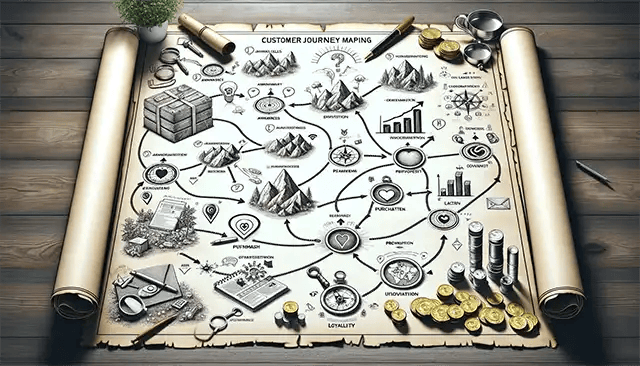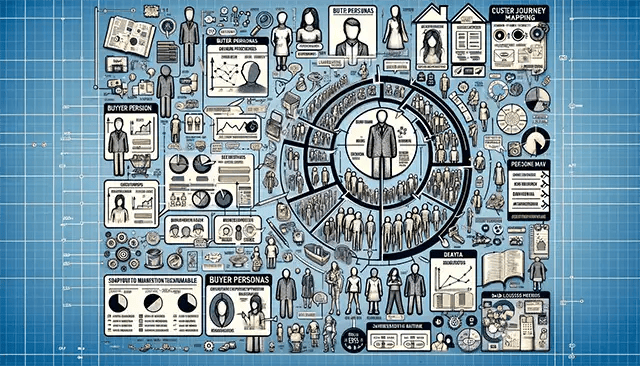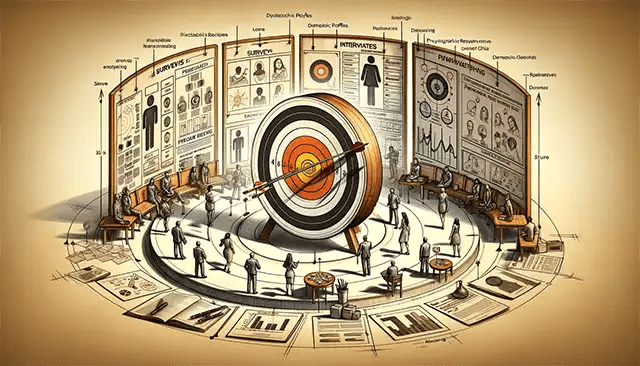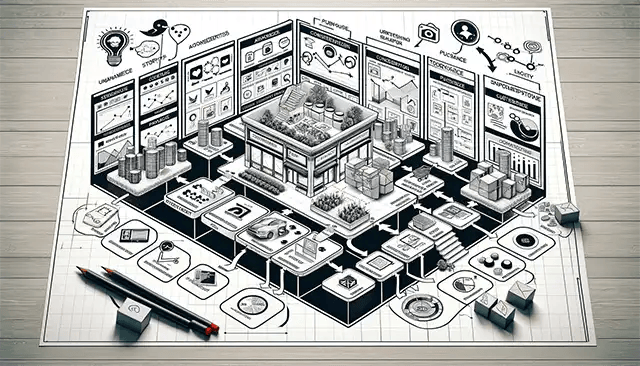Creating Customer Journey Maps: A Guide for Marketers
- Home
- Creating Customer Journey Maps: A Guide for Marketers
Imagine you're an inbound marketing detective, piecing together clues to understand the story behind each customer's journey. That's what creating customer journey maps is all about—unlocking insights and templates that turn average experiences into remarkable ones.
You're not just drawing lines on a chart; you're diving deep into the emotional highs and lows your customers encounter. With every step they take, from first glance to final purchase, there's something to learn—and use—to make their path smoother. This exploration isn't for the faint of heart. It takes grit and empathy but promises rewards like increased sales and loyalty. Stick around as we uncover how crafting detailed buyer personas and analyzing customer touchpoints can illuminate paths once hidden in shadow.
Table Of Contents:
- Understanding the Fundamentals of Customer Journey Maps
- The Benefits of Customer Journey Mapping for Businesses
- Creating Buyer Personas for Effective Mapping
- The Benefits of Customer Journey Mapping for Businesses
- Creating Buyer Personas for Effective Mapping
- Conducting Thorough Persona Research
- Steps to Visually Mapping the Customer Journey
- Conclusion
Understanding the Fundamentals of Customer Journey Maps
If you aim to make your customers feel like rock stars on a red carpet, then knowing their every step is key. That's where customer journey maps enter the scene. These visual representations are not just fancy diagrams; they're essential tools that outline a customer's steps with your brand—from first hearing about you to becoming a loyal fan.
What is a Customer Journey Map?
A customer journey map might sound like something from an Indiana Jones movie, but it's more akin to sheet music for an orchestra. Each note guides different instruments (or departments) through harmonious play. This map tracks all touchpoints and experiences from when someone becomes aware of your brand until they buy. It’s not simply about plotting points; it’s understanding how each experience influences feelings and decisions.
Say goodbye to guesswork because these maps let us peek into our customers' minds, revealing what delights or irks them at each stage in their quest for solutions we offer.
The Role of Customer Journey Maps in Business Strategy
Buckle up. Your business strategy can take off once you understand how vital these journey maps are—they're like GPS systems guiding marketing campaigns towards success by providing insights into real-life customer behaviours and pain points. Imagine having X-ray vision: seeing beneath surface-level data lets businesses align services better with user needs, leading directly toward achieving those sky-high business goals.
We aren't just making this stuff up, either—a whopping 94% of businesses reported that using customer journey maps sparked ideas for new products and services tailored perfectly to their customers' needs.
The Benefits of Customer Journey Mapping for Businesses
You've heard tales about companies hitting jackpot sales figures overnight—it wasn't magic beans; chances are high they had solid mapping strategies behind closed doors. Indeed, studies show 91% have seen driving sales soar thanks partly to the adept use of insightful tools such as map type and comprehensive charts outlining every nuance in consumer-brand interactions.
Creating Buyer Personas for Effective Mapping
Research shows that tailoring content based on detailed buyer personas and mapping an existing customer journey results in higher engagement rates. This is because messages resonate deeper when they mirror specific audience segments and are relevant as the customer moves through the different stages.
Conducting Thorough Customer Persona Research
In-depth research involving mapping customer journeys using surveys and interviews to collect customer data gifts us pearls worth more than any treasure chest about all those different customer personas—the raw truths from our target audiences’ mouths.
Let's start by taking a closer look at today's agenda. We'll tackle each item precisely, ensuring nothing is overlooked, and every detail is addressed thoroughly.
Customer journey maps are your brand's roadmap, showing precisely what customers love or loathe. They're the secret sauce behind those jaw-dropping sales boosts, and new product wins.

The Benefits of Customer Journey Mapping for Businesses
Picture this: a powerful tool that could boost your sales through the roof. According to recent studies, that's precisely what customer journey mapping has done for 91% of businesses. But the benefits don't just stop at ringing cash registers; they extend into product development and enhancing engagement with those who matter most—your customers.
Driving Sales with Precision
A customer journey map is like a treasure map, leading you to where X marks the spot—the sale. It lets you step into your customers' shoes and see their experience from awareness to purchase (and beyond). This insight is golden because when you know every twist and turn in their path, you can smooth out any bumps along the way. And guess what? Smoother journeys mean more sales.
But how much smoother are we talking about here? A Hanover Research report tells us that nearly every business using these maps saw an uptick in sales—talk about striking gold.
Crafting Customer Experiences That Resonate
Better engagement isn't just good vibes—it's smart business. When customers feel understood and valued at each touchpoint, they're more likely to stick around and even spread the word about how great your brand is. Your map becomes a guidebook for creating a user experience tailored specifically for them.
You'll also want feedback loops built in throughout their journey because, let’s face it, who doesn’t love feeling heard?
Innovating Products Like a Prodigy
Gone are the days when products were thrown against a wall like spaghetti noodles, hoping something would stick—that’s not how winning businesses operate anymore. Today’s top players use customer journey maps as innovation incubators, pinpointing existing pain points or unmet needs within each phase of interaction with users’ help.
This kind of hands-on intel led 94% of companies surveyed to develop new offerings aligned perfectly with consumer desires—you’re practically reading minds at this point.
Navigating Through Uncertainty With Ease
If there was ever proof needed that adaptability equals survival during tough times, look no further than our friend CJM (customer journey mapping). One-third used these trusty blueprints to navigate changes brought upon by events such as pandemics—they had secret weapons up their sleeves while others scrambled without direction.
With strategies backed by visual representations, you'll see potential pitfalls before they happen. This proactive approach lets you tackle challenges head-on and streamline your path to success.
Think of a customer journey map as your sales compass. It guides you to the sweet spot where customers are ready to buy, helping you create smoother paths that lead to more sales and better products.
It's not just about closing deals; it’s also crafting experiences that make people stick around and rave about your brand. And when things get shaky, this map is your secret weapon for confidently navigating through uncertainty.

Creating Buyer Personas for Effective Mapping
Picture this: you're crafting a roadmap, but instead of hills and rivers, it's filled with thoughts and choices. That's the essence of creating buyer personas; they are not just sketches on paper—they are vivid portraits that embody your potential customers' needs, goals, and behaviour patterns. These detailed characters set the stage for more accurate customer journey maps, which in turn help businesses hit their targets like an arrow hitting a bullseye.
The Cornerstone of Journey Maps: Crafting Your Buyer Personas
Creating buyer personas that genuinely resonate with your audience requires more than guesswork—it demands data. Dive into analytics to understand who interacts with your brand online or survey existing users to glimpse their worlds. It's about piecing together demographic information, lifestyle preferences, and shopping habits—essentially any intel that clearly shows who is likely to buy from you.
An effective mapping starts here because once you know who is embarking on this journey through touchpoints galore—from social media banter to post-purchase support—you can better anticipate each step they take and the experience they seek.
Making Sense Out Of Data – The Persona Profile Puzzle
Gathering quantitative data alone won't cut it, though. Qualitative insights give life to numbers by adding context around what makes customers tick—their motivations, frustrations, and pain points (yes, those pesky obstacles our heroes must overcome). Through interviews or surveys—a technique touted by experts—you'll get firsthand accounts providing depth beyond mere statistics.
Incorporating both types of data ensures that when someone visits your online store or interacts with marketing campaigns, every element speaks directly to them because, let’s face it—nobody wants generic experiences anymore.
Tailoring Content & Strategies To Fit Each Unique Customer Segment
Recent studies reveal an eye-opening statistic: 94% believe these persona-driven journey maps empower them to understand how customers behave and enable innovative product development tailored specifically to consumer desires.
This increases customer engagement since individuals feel seen and understood—not as part of an indistinct crowd but recognized for their unique preferences. Isn’t being understood what we all yearn for?
Set goals and get to know your customers like the back of your hand. Use data and personal stories to build buyer personas that guide precise customer journey maps so every marketing move feels tailor-made for each shopper.

Conducting Thorough Persona Research
In marketing, you must know who's holding the bow to hit the bullseye. That’s where persona research comes into play—researching multiple personas is like drafting a detailed dossier on your ideal customer. Get this right and create buyer personas, and you're not just shooting arrows in the dark; you’re Robin Hood at an archery contest.
Using Surveys and Interviews for In-Depth Insights
The best insights often come straight from the horse's mouth. To conduct powerful persona research, start with surveys and interviews to create customer personas. This isn't about skimming the surface; we're talking deep dives here—discovering what makes customers tick, their pain points, dreams, and daily routines.
You can kick things off by designing surveys that ask pointed questions but let folks elaborate beyond 'yes' or 'no'. Then move on to one-on-one interviews- gold mines for nuance—you’ll unearth gems of information that might never have sparkled through in a survey alone.
In these conversations, it pays to listen more than talk. Encourage interviewees to share stories about their experiences with your brand or similar products. You'll get richer data when people open up rather than respond with cookie-cutter answers—and trust me, there’s nothing sweeter than actionable customer anecdotes sprinkled over your strategy.
Gathering all this qualitative data helps give shape to those personas—the fictional yet factual characters representing segments of your audience. But remember: always balance stories with stats. Back up personal accounts with quantitative data whenever possible because numbers don’t lie (but they do tell compelling tales).
Diving Into Demographics & Psychographics
We’ve covered how vital direct feedback is—now let's do some detective work on demographics and psychographics, too. The former covers age brackets, while the latter gets cosy with lifestyle choices. That sort of thing adds colour to our character sketches, making them as real as reality TV stars (without drama).
- Demographic details help pinpoint aspects like income level, which may influence buying power.
- Psychographic profiles delve deeper into beliefs, values, and hobbies—these nuances can guide product development toward something truly resonant.
Hanover Research showed us that 94% of businesses witnessed new products and services blossom when they matched them against refined customer needs to be drawn from journey maps. So why stop at basic biographical info? Mix in media habits and check social media engagement to see what platforms potential buyers frequent most—you might find surprising hotspots ripe for targeted marketing campaigns.
To nail your marketing, do your homework on who's buying. Use surveys and interviews to dig deep into customer stories—this is where you'll strike gold for crafting spot-on personas.
Don't rely on gut feelings; mix honest conversations with complex data. Add demographics and psychographics to paint a complete picture of who engages with your brand.

Steps to Visually Mapping the Customer Journey
Creating a customer journey map is like crafting a storybook of your brand's relationship with its existing customer base. It lays out each twist and turns, from first glance to happy ever after.
Selecting an Appropriate Template That Fits Your Business Model and Enhances Understanding
The suitable map template works as your canvas; it sets the stage for insights to bloom. Imagine you're painting: You wouldn't use watercolours on sandpaper, right? So why force a one-size-fits-all approach when mapping the customer journey?
Pick a template that mirrors how customers interact with your business—whether they stroll through an online store or chat with sales reps at a physical location. This choice can make or break your understanding of touch points where you meet—or miss—the mark.
You'll find templates ranging from service blueprints highlighting behind-the-scenes processes to more straightforward linear timelines suited for simpler paths. Each serves its purpose but choosing wisely ensures every data stroke paints the perfect picture of your customer’s experience.
Determining Key Stages in The Customer Experience
Akin to chapters in our storybook, defining stages helps us see how characters—our customers—move along their path. Is there an introduction via social media? A plot twist during product research? Or maybe resolution comes within stellar customer support encounters? Mapping a customer journey helps to target specific goals and better understand customer needs.
Jot down these critical moments as milestones on our map because customer mapping is vital—94% of businesses have improved their products by getting this part right.
Hanover Research tells us much about what happens when we align offerings with genuine human experiences.
Gathering and Integrating Data Across Touchpoints
Data is not dry facts; it's narrative gold. When mapping the customer journey visually, we sift through surveys and interviews—even those net promoter scores—to uncover tales told through behaviour patterns and positive customer feedback loops.
Recent studies reveal that over 90% of businesses who let data guide their maps saw drives in sales and will increase customer retention—a testament worthy of headlines.
Incorporating Quantitative Data For Precision
To give life-like precision to our character sketches (buyer personas), quantitative data offers numerical certainty amidst subjective hues: How many abandon carts before checkout? What percentage clicks past page three?
Think of your customer journey map as a storybook, with every touchpoint an opportunity to connect. Pick the suitable template—like choosing the best paint for your canvas—to make insights pop and reflect how customers engage with you.
Dig into data like narrative gold; it'll help pinpoint crucial moments that shape the customer experience. It's more than numbers—it's about understanding real-life interactions that could improve products and increase sales.
Conclusion
Creating customer journey maps is like uncovering a treasure map. Each X marks where your customers' experiences can turn into gold.
Start by getting to know your audience. Crafting buyer personas isn't just busy work; it's crucial for accurate mapping that reflects real people, not just numbers.
Dig deep with data collection. Use surveys and customer behaviour analysis to ground your map in reality—because guessing games won't cut it.
And remember: every touchpoint matters. From social media glances to checkout clicks, they're all puzzle pieces of the larger picture you're piecing together to map those customer behaviours.
Incorporate multi-channel strategies thoughtfully—it's about choosing quality over quantity when engaging customers across various platforms.
Your mission? To create a positive customer experience and make those customer journeys shine brighter than before, turning potential into loyalty one insight at a time.
Frequently Asked Questions About Customer Journey Mapping
What are the main benefits of customer journey mapping?
Customer journey mapping offers numerous benefits, including:
- Increased sales and customer retention
- Improved customer experiences across all touchpoints
- Enhanced product development based on customer insights
- Better alignment of marketing strategies with customer needs
- Increased customer engagement and loyalty
How do I create effective buyer personas for journey mapping?
To create effective buyer personas:
- Conduct thorough research using surveys, interviews, and analytics
- Gather both demographic and psychographic data
- Analyze customer pain points, goals, and behaviours
- Create detailed profiles that represent your target audience segments
- Regularly update personas based on new data and insights
What are the best practices for gathering customer data for journey mapping?
Follow these best practices when gathering customer data:
- Use a mix of quantitative and qualitative research methods
- Conduct in-depth interviews with existing customers
- Analyze customer feedback and support interactions
- Leverage analytics tools to track online behaviour
- Ensure data collection complies with privacy regulations
How can I effectively visualize my customer journey map?
To create a compelling visual representation of your customer journey map:
- Choose an appropriate template that fits your business model
- Clearly define critical stages of the customer experience
- Use colour-coding to highlight emotions and pain points
- Include relevant data and insights at each touchpoint
- Ensure the map is easy to understand and share across teams
What are common challenges in customer journey mapping, and how can I overcome them?
Common challenges in customer journey mapping include:
- Lack of cross-departmental collaboration: Foster communication and shared goals across teams
- Insufficient data: Implement robust data collection methods and tools
- Difficulty in quantifying emotions: Use surveys and interviews to gather qualitative insights
- Keeping maps up-to-date: Regularly review and update journey maps based on new data
- Translating insights into action: Develop clear action plans based on map findings




